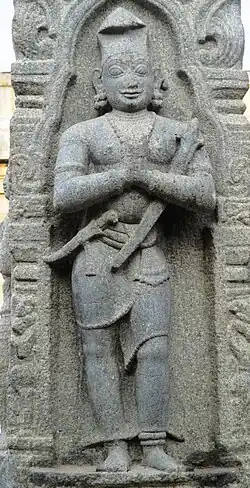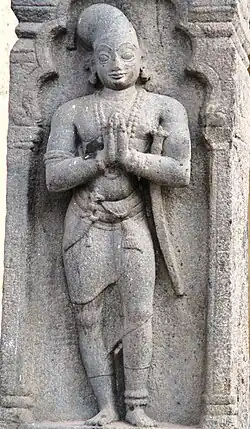Rajagopalaswamy Temple, Mannargudi
| Sri Vidhya Rajagopalaswamy Temple | |
|---|---|
Champakaranya Kshetram | |
| Religion | |
| Affiliation | Hinduism |
| District | Tiruvarur |
| Deity | |
| Festivals | Panguni Brahmotsavam, Thiruvadipooram, Teppotsavam, Thirupavithrotsavam, Navaratri Utsavam, Kolatta Utsavam, Deepotsavam, Adhyayana Utsavam, Dolotsavam, Etc. |
| Features |
|
| Location | |
| Location | Mannargudi |
| State | Tamil Nadu |
| Country | India |
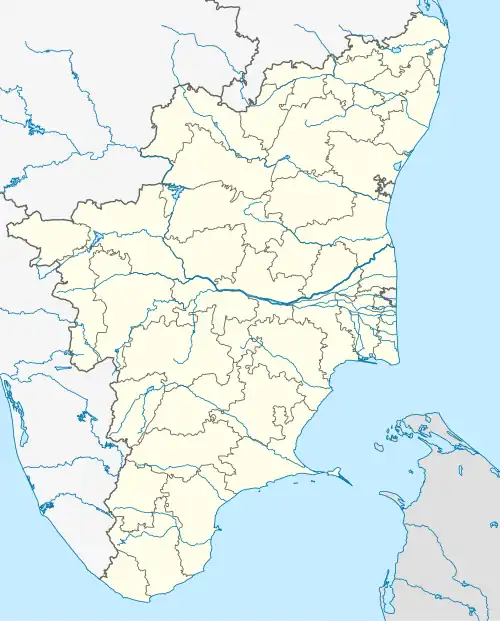 Location in Tamil Nadu | |
| Geographic coordinates | 10°40′1″N 79°26′32″E / 10.66694°N 79.44222°E |
| Architecture | |
| Type | Tamil architecture |
| Creator | Kulothunga Chola I, Later Chola Kings |
| Elevation | 46.93 m (154 ft) |
| Website | |
| https://hrce.tn.gov.in/hrcehome/index_temple.php?tid=14267 | |
Sri Vidhya Rajagopalaswamy temple is a Vaishnava shrine located in the town of Mannargudi, Tamil Nadu, India.[1] The presiding deity is Rajagopalaswamy, a form of Krishna and his consort Lakshmi, who is worshipped as Sri Sengamala Thayar. The temple is spread over an area of 9.3 ha (23 acres) and is an important Vaishnava shrines in India. The temple is called Champakaranya Kshetram, Dakshina Dwaraka (Southern Dvaraka) along with Guruvayoor by Hindus[2], Vanduvaraapathi and Vasudevapuri. It is considered first among the 108 Abhimana Kshethram of Vaishnavate tradition.
Originally this ancient temple was first constructed by Kulothunga Chola I at 10th century and Chola Kings Rajaraja Chola III, Rajendra Chola III and later expanded by Thanjavur Nayaks during the 16th century. The temple has three inscriptions from the period and also mention in the religious texts. A granite wall surrounds the temple, enclosing all its shrines and seven of its nine bodies of water. The wall is celebrated in Tamil as “Mannargudi Mathil Alagu”, meaning "the beauty of the walls," highlighting its grandeur and cultural significance. The temple has a 47 m (154 ft) rajagopuram, the temple's gateway tower. The temple is associated with nine theerthams (sacred water bodies): Haridranadhi, Durvasa Theertham (also called Gajendra Theertham), Thirupparkadal, Gopika Theertham (also known as Gopralaya Theertham), Rukmini Theertham, Sanghu Theertham, Chakkra Theertham, Agnikunda Theertham, and Krishna Theertham, along with the Pambani River. Among them, Haridra Nadhi, the temple tank associated with the temple is outside the temple complex and is considered one of the largest temple tanks in India.
Pundarikakshan is believed to have appeared as Krishna to sages Gopillar and Gopralayar.
Six daily rituals and three yearly festivals are held at the temple, of which the chariot festival, celebrated during the Tamil month of Panguni (March–April), being the most prominent. The temple is maintained and administered by the Hindu Religious and Endowment Board of the Government of Tamil Nadu.
Architecture
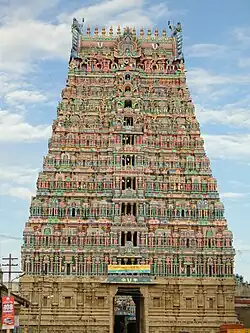
The history of Mannargudi in centered around the Rajagoplaswamy temple. The temple has a large gopuram (gateway tower) facing east with a temple tank in the north eastern direction. The central shrine is located axial to the gateway and the flagpost and approached through a series of pillared halls. The image of the presiding deity is 156 inches tall and sported in a seated posture with his consorts Satyabhama and Rukmini on his sides. There is a big tank at the entrance of the shrine where rain water is collected. The temple complex has 16 gopurams (tower gateways), 7 prakarams (outer courtyard), 24 shrines, seven mandapams (halls) and nine sacred theerthams (temple tanks). The utsava (festival deity) is a bronze figure from the Chola period. It shows keshabanda type of coiffure and restrained ornamentation, atypical of the Chola bronzes of the 11th century.[3] The temple tank is called Haridra Nadhi, 353 m (1,158 ft) long and 255 m (837 ft) broad (9.3 ha (23 acres)), making it one of the largest temple tanks in India.[2][4] The shrine of Sengamalathayar (also called Hemabhujavalli) is located in the second precinct around the sanctum. The temple has a thousand pillared hall.[5]
Shrines and Temple Orientation
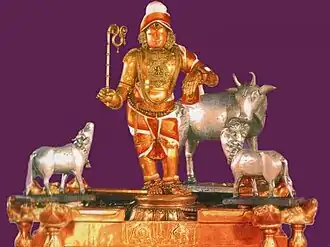
The temple complex of Mannargudi Rajagopalaswamy Temple includes 24 shrines, primarily dedicated to Vishnu in various forms, Sri Lakshmi as Sengamala Thayar, and numerous Alwars and Vaishnava acharyas. The central sanctum enshrines Sri Paravasudeva Perumal, accompanied by Sri Devi and Bhu Devi. The processional deity, Sri Vidya Rajagopalan, is depicted in a majestic seated posture flanked by his consorts Sri Rukmini and Sri Satyabhama, reflecting the divine cowherd form (Gopala) of Krishna. [6] The Mahamandapam (Sabha) in front of the sanctum has ornate brass-plated pillars and opens into the first circumambulatory path, Thiruvaimozhi Prakara, considered the most sacred passage around the sanctum. Within this innermost prakara are shrines for Vinayaka (Ganesha) and Durga, the latter venerated locally as Vishnudurgai and Gajendra Azhwar, a rare feature shared with temples like Srirangam. Moving westward from the sanctum, the Ardha Mandapam and additional mandapas house associated icons and are used for daily and festival rituals. [7]

The second prakara, known as Garuda Prakaram, features shrines for Garuda, Jaya and Vijaya the guardians of Vaikuntha, and the Utsava Murti of Perumal. This precinct also includes sanctums for various Vishnu avatars and forms such as Venugopala, Lakshmi Narasimha, Ananta Padmanabha, Lakshmi Narayana, and Gajendra Varada, highlighting the theological range of Vishnu’s roles in Vaishnavism. At the northeastern edge of the prakara, shrines for Vishvaksena, the commander of Vishnu’s army, and Sutravati Devi are present, along with a vahana mandapa for housing the temple’s gold and silver mounts. A subterranean passage is also traditionally believed to exist beneath this region. The third enclosure, Champaka Prakaram, named after the champaka groves that once flourished here, houses numerous shrines and ritual structures. Prominent among these are shrines for Andal, Nammalvar, Manavala Mamunigal, Periyalwar, Kulasekhara Alwar, Tirumangai Alwar and Kumudavalli, as well as Thondaradippodi Alwar and Anjaneya, who is worshipped alongside Chakkarathazhwar. A mandapam nearby is used for Kodai Utsavam and Vasantha Utsavam celebrations. The sacred Madappalli (temple kitchen), associated with Madaipalli Nachiyar, is also situated in this prakara. [8]
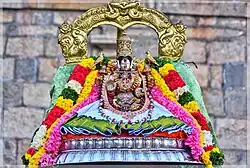
The shrine of Sri Sengamala Thayar, a central and independently celebrated deity of the temple, is situated in the southern section of this prakara. It houses the Moolavar (Sri Shenbagavalli Thayar) and Utsavar (Sri Sengamala Thayar). The shrine complex includes the Nritya Mandapam, the Glass Mandapam, the Vaikunta Sabha (Rohini Mandapam), and the Flagmast with sculptures of Garuda and Suparni, a rare representation. On Fridays and during festivals like Mattaiyadi Utsavam, Thayar Adhyayana Utsavam, and Ekasimhana Utsavam, Thayar receives special abhishekam and darshan rituals, often accompanied by the chanting of the Gadya Traya composed by Ramanuja. Extending from this zone is a shrine complex for Sri Rama, with associated mandapams including the Nritya Mandapam, Maha Mandapam, Artha Mandapam, and the Sri Paduka Mandapam, alongside the Paramapada Entrance and Pancha Parva Utsava Mandapam. The sacred Punnai Tree, identified as the temple’s sthala vriksha, stands nearby, along with the Yagasala, used for Vedic sacrifices and rituals. In front of the main sanctum lies the Vadya Mandapam, featuring historic depictions of Achyutappa Nayak, Vijaya Raghava Nayak, and Rani Champakalakshmi. Nearby, the Uttara Mandapam and Perarulalan shrine are used during Pagal Pattu and Brahmotsavam festivities.
The fourth prakara, Kasi Prakaram, includes the grand Thousand-Pillared Mandapam, the Tirumamani Mandapam—central to Vaikuntha Ekadasi rituals—and mandapams for Vedic discourse and public worship. Shrines for Kurattalwar, Udayavar (Ramanuja), and Sri Nigamata Maha Desikan—the only Vadakalai shrine in the temple—are located here. A public drinking water well and other practical structures are also situated in this area.The fifth circumambulatory path, Nachiyar Prakaram, is unique in that it hosts the chariot procession of Sri Sengamala Thayar, a rare tradition where the goddess, rather than the lord, takes part in a separate ratha utsavam. The prakaram includes multiple gopurams, such as the Western Gopuram used historically by Thanjavur kings, and sacred tanks reserved for Thayar’s worship. It also contains the Elephant shelter, Cow Shed, Sixteen-Pillared Mandapam for the Tiruvandikkappu ritual, and the Yoga Narasimha shrine. A newly constructed mandapam offers a prominent view of the Krishna Gopura, adding to the temple’s ceremonial architecture. Together, these shrines reflect a vibrant ecosystem of Vishnu devotion, Lakshmi worship, Alwar veneration, and rich liturgical tradition. The spatial arrangement, iconography, and ceremonial use of each shrine contribute to the temple’s status as a significant center of Sri Vaishnavism in Tamil Nadu.
Halls of the Temple
The Rajagopalaswamy Temple complex features a series of richly constructed mandapams (pillared halls) that serve as both architectural highlights and focal points during temple rituals and festivals.

These halls are strategically located across the prakarams (circumambulatory enclosures), contributing to the functional layout of the temple and enhancing the visual and devotional experience of devotees. Several circumambulatory paths—such as Tiruvunnazhi Prakaram, Garuda Prakaram, Champaka Prakaram, Kasi Prakaram, and Nachiyar Prakaram—are known for their spaciousness and architectural elegance. The mandapams located along these paths play a central role during major temple events, especially the annual Brahmotsavam and the Adhyayana Utsavam. [9]
The temple features seven principal mandapams, each associated with specific utsavams and traditions:
- Vallala Maharaja Mandapam: This hall is actively used during the Pagal Pathu portion of the Adhyayana Utsavam and during the Kollatta Utsavam, a unique local celebration. It is also a point of royal historical interest, reflecting regal patronage.
- Thousand-Pillared Mandapam: One of the most iconic halls in the temple, it hosts the Raa Pathu segment of the Adhyayana Utsavam and major celebrations like the Navaratri Utsavam. It is known for its vast space and rows of intricately carved granite pillars, exemplifying Nayak architecture.
- Garuda Vahana Mandapam: This mandapam plays a key role during the Garuda Sevai on the twelfth day of the Panguni Brahmotsavam, where the utsava murti of Perumal is brought here before being seated in the Chapparam (processional canopy).
- Yanai Vahana Mandapam: During the Panguni Brahmotsavam, most vahana processions commence from this mandapam. It acts as a preparatory area for the various festival mounts of the deity.
- Lattice-Window Mandapam (Palakani Mandapam): Known for its elegant stone lattice work that allows for a balcony-style view, this mandapam is used during Rohini Nakshatram when the Utsavar Sri Perumal proceeds here for Thirumanjanam (ritual bathing ceremony).
- Butter and Pot Mandapam (Vennai Thazhi Mandapam): Associated with the Vennai Thazhi Utsavam, a Krishna-themed celebration during the Brahmotsavam, this mandapam is where Sri Rajagopalan is taken in procession to recreate the divine play of Krishna stealing butter.
- Mast-Wood Vehicle Mandapam (Punnai Vahana Mandapam): This hall is central to the Punnai Vahana Utsavam during Brahmotsavam, in which the deity is taken across the temple’s sacred precincts, traditionally even symbolizing a journey across the Kaveri River.
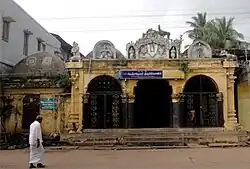
Additional functional mandapams found throughout the temple include the Nritya Mandapam, Maha Mandapam, Artha Mandapam, and the Sixteen-Pillared Mandapam (Sri Paduka Mandapam), each of which plays a role in ritual recitations, darshan arrangements, and seasonal ceremonies. The Pancha Parva Utsava Mandapam, Paramapada Entrance, and Yagasala further support the temple’s extensive festival calendar and Vedic rites. These mandapams not only reflect the temple’s rich architectural legacy but also form the sacred stage upon which the temple’s ceremonial life unfolds throughout the year.
History
The originally temple was first constructed by Kulothunga Chola I(1070-1125 CE) stone inscription found in the site.[10] The place Mannargudi is termed Sri Rajathi Raja Chathurvedhi Mangalam[11] and the town started to grow around the temple. Successive kings of the Chola empire, Rajaraja Chola III, Rajendra Chola III and kings of Thanjavur Nayaks, Achyuta Deva Raya[12] expanded the temple. The temple contains inscriptions of the Hoysala kings and some Vijayanagara grants, and many records of the later Nayaks and Marathas.[13] The Thanjavur Nayaks made the temple as their dynastic and primary shrine and made significant additions.[14] The current temple structure, hall of 1000 pillars, main gopuram (temple gateway tower) and the big compound wall around the temple was built by the king Vijayaraghava Nayak (1532–1575 CE).[10] Raghunathabhyudayam, a doctrine by Nayaks explains the donation of an armour studded with precious stones to the main deity by the king.[12] He erected the big tower in the temple so that he can view the Srirangam Ranganathaswamy temple from the top of Mannargudi. The Nayaks were specially interested in music and it was promoted in both the temples. Instruments like Mukhavina, Dande, Kombu, Chandravalaya, Bheri and Nadhasvaram were commonly used in the temple service.[15]
According to historian K.V. Soundararajan, the Rangantha temples in South India built during the 9th and 10th centuries have a systematic arrangement of subsidiary deities as seen in this temple along with the Appakkudathaan Perumal Temple at Koviladi, Sowmya Narayana Perumal temple at Thirukoshtiyur, Veeraraghava Perumal Temple at Thiruvallur and Rangantha temple at Srirangapatna.[16]
Festival
The temple priests perform the puja (rituals) every day, including festivals. Like other Vishnu temples of Tamil Nadu, the priests belong to the Vaishnavaite Brahmin caste. The temple rituals are performed four times a day; Kalasanthi at 8:30 a.m., Uchikalam at 10:00 a.m., Sayarakshai at 6:00 p.m. and Ardha Jamam at 8:00 p.m. Each ritual comprises three steps; alangaram (decoration), neivethanam (food offering) and deepa aradanai (waving of lamps) for the presiding deity. The worship involves religious instructions in the Vedas (sacred text) read by priests and prostration by worshippers in front of the temple mast. There are weekly, monthly and fortnightly rituals.
Annual Utsavams
The temple witnesses a vibrant array of Brahmotsavams, Utsavams, and annual festivals, uniting the community in devotion and tradition. These celebrations span all twelve months of the Tamil calendar and are deeply rooted in Vaishnavite liturgical heritage. The most significant is the eighteen-day Panguni Brahmotsavam, culminating in the Rathotsavam (Chariot Festival) on Panguni Rohini, commemorating the Thirunakshatram (birth star) of Sri Vidhya Rajagopalaswamy. Each month features unique festivals such as Garuda Sevai, Theppotsavam, Navaratri, Vaikunta Ekadashi, and various Theerthavari rituals. These utsavams are marked by processions, traditional music, Vedic recitations, and distinctive forms of divine worship, drawing devotees in large numbers and sustaining the temple’s vibrant religious life throughout the year.
Panguni (March–April)
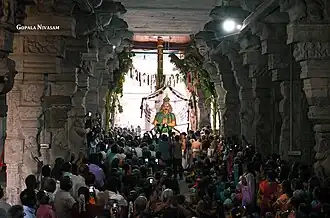
The major festivals celebrated in the temple are 18-day Panguni Brahmotsavam in honor of Sri Sri Vidhya Rajagopalaswamy’s Thirunakshatram. During the second day, the enactment of the famous story of Krishna taking away the dress of bathing females, the females requesting the clothes back and Krishna singing the flute.[2] The festival deity is placed in the punnai tree, the branches of which are hung with garments and ornaments.[2] On the sixth day, Sri Rajagopalan appears in Raja Alankaram and mounts the rare Kanda Peranda Pakshi Vahanam, a celestial bird venerated in all Divya Desams and uniquely associated as His exclusive mount. On the twelfth day, the renowned Garuda Sevai takes place—one of the most revered events in Vaishnavite tradition. Sri Perumal, adorned in Vaikunthanathan Thirukolam, graces the occasion seated on the Golden Garuda Vahanam, accompanied by the traditional Twin Umbrella Sevai. This grand procession symbolizes divine protection and is celebrated with exceptional devotion and grandeur. The sixteenth day is marked by the deeply devotional Vennai Thazhi Utsavam[17], a sacred festival observed in several Divya Desams. However, it is only at Mannargudi that this utsavam features the extraordinarily unique and spiritually intimate tradition of devotees personally offering fresh butter directly onto Sri Perumal’s Thirumeni. Adorned in Navaneetha Sevai attire, seated gracefully in a palanquin and holding a pot of butter, Sri Rajagopalan receives this offering in a manner that reflects the divine Krishna’s leelas. This rare gesture of direct offering symbolizes unparalleled closeness between the devotee and Sri Krishna, making it one of the most soul-stirring moments of the entire Brahmotsavam. It exemplifies the deep, personal devotion that defines the unique spiritual culture of Mannargudi.
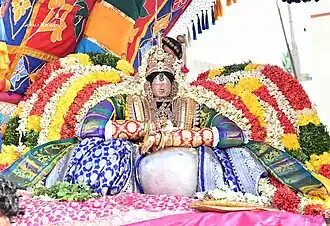
The Chariot Festival, celebrated on Panguni Rohini, marks the Thirunakshatram (birth star day) of Sri Vidhya Rajagopalaswamy and is the most prominent festival of the temple. It falls on the 17th day of the Panguni Brahmotsavam and is celebrated with grandeur by the temple and the surrounding villages. It is celebrated during the Tamil month of Panguni (March–April); devotees pull a chariot round the streets of Mannargudi. Verses from the Nalayira Divya Prabandham are recited by a group of temple priests and music made with nagasvaram (pipe instrument) and tavil (percussion instrument) is played. In addition to the Panguni Brahmotsavam, the temple observes several other annual festivals across the Tamil calendar and tavil (percussion) music. In addition to the Panguni Brahmotsavam, the temple observes several other important festivals throughout the Tamil calendar.
Chithirai (April–May)
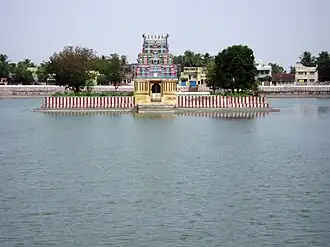
During the Tamil month of Chithirai, the temple observes the Chithirai Kodai Utsavam, a spring festival marked by processions and special alankarams. The highlight of this festival is the Golden Garuda Sevai, held on Akshaya Tritiya, an auspicious day in the Vaishnavite tradition. On this day, Sri Rajagopalan is taken in procession mounted on the Golden Garuda Vahanam, attracting large numbers of devotees. The festival is celebrated with traditional music, Vedic chanting, and floral decorations, symbolizing prosperity and renewal. It serves as a continuation of the temple’s festive calendar following the grandeur of Panguni.
Vaikasi (May–June)
In the Tamil month of Vaikasi, the temple celebrates the Vasanthotsavam, a spring-themed festival signifying freshness and divine grace. The festival includes daily processions and floral decorations, invoking the spirit of rejuvenation. It culminates in the Udhaya Garuda Sevai, during which Sri Rajagopalan is taken out in a morning procession on the Garuda Vahanam, symbolizing auspicious beginnings and divine protection. The event is marked by Vedic recitations, traditional instruments, and devotional gatherings, continuing the temple’s cycle of monthly observances with ceremonial elegance.
Aani (June–July)
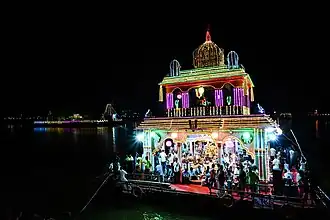
The Tamil month of Aani is marked by the celebration of the Aani Theppotsavam, the annual float festival of the temple. The highlight of this festival is the Theppam (float procession) held at the Haridra Nadhi Teppakulam, the temple’s sacred tank. On the day of the event, the festival deities are placed on a beautifully decorated float and taken across the tank, accompanied by Vedic chanting, musical performances, and the illumination of oil lamps along the tank’s perimeter. This visually striking celebration symbolizes the divine presence upon the waters and draws large crowds of devotees who gather to witness the serene and auspicious event.
Aadi (July–August)
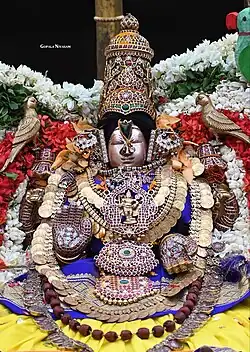
In the Tamil month of Aadi, the temple observes two important festivals: the Thiruvadipuram Utsavam and the Jyeshtabhishekam. The Thiruvadipuram Utsavam is celebrated in honor of Sri Sengamala Thayar’s Thirunakshatram, during which she is venerated in the form of Andal, considering Sri Rajagopalan as Raja Mannar, reflecting the divine wedding theme central to Vaishnavite devotion. Alongside this, the annual Jyeshtabhishekam is performed, during which the Swarna Kavasam (golden armor) of the deity is ceremonially removed, offering devotees the rare Nijaroopa Darshanam during the sacred Thirumanjanam (ritual bathing). These festivals are observed with reverence, marked by special rituals, Vedic chants, and large devotional gatherings.
Aavani (August–September)
The Tamil month of Aavani at the Sri Vidhya Rajagopalaswamy Temple is marked by two important observances: Uriyadi Utsavam and Thirupavithrotsavam. In connection with Sri Krishna Jayanthi, the Uriyadi Utsavam is celebrated with great enthusiasm, featuring the symbolic recreation of Lord Krishna’s leelas—particularly the playful act of breaking butter pots. Sri Perumal is taken out in procession, and the festivities, involving children and youth, reflect devotion through joyful participation. Following this, the ten-day Thirupavithrotsavam is conducted as a sacred purification rite. This ritual aims to atone for any lapses or ritual errors that may have occurred during the year’s daily and festival worship. The festival includes homams (sacred fire offerings), Pavithra Samarpanam (adorning the deities with sanctified threads), and culminates with the Theerthavari ceremony, signifying the restoration of spiritual purity and ritual completeness.
Purattasi (September–October)
During the Tamil month of Purattasi, the Sri Vidhya Rajagopalaswamy Temple observes the Navaratri Utsavam, a significant festival dedicated to Sri Sengamala Thayar. Celebrated with Raksha Bandhan rituals, the festival spans nine days, during which the goddess is adorned with different alankarams and taken in daily processions amid Vedic chanting, devotional singing, and traditional offerings. The festival honors the divine feminine energy, invoking blessings for prosperity, protection, and spiritual upliftment. On Vijayadasami, which marks the culmination of the Navaratri celebrations, Sri Rajagopalaswamy appears resplendently mounted on the Golden Horse Vahanam, followed by a ceremonial ambhu poduthal (archery event), symbolizing the triumph of dharma. The festival draws large gatherings of devotees, particularly women and families, who offer lamps, bangles, turmeric, and other auspicious items to the goddess in devotion.
Aippasi (October–November)
In the Tamil month of Aippasi, the temple celebrates the Deepavali Kolatta Utsavam, a ten-day festival held in connection with Deepavali. Sri Rajagopalaswamy, in his Krishna avatar, is taken in procession within the temple precincts, adorned in festive alankaram. The event features Kolattam performances by women and children, devotional music, and lamp lighting throughout the temple, symbolizing the victory of light over darkness. The utsavam highlights the joyful spirit of Krishna and fosters collective devotion.
Karthigai (November–December)
In the Tamil month of Karthigai, the temple observes the Karthikai Deepotsavam, coinciding with the sacred Karthikai Deepam, an important festival in Tamil Vaishnavite tradition. The temple is adorned with rows of agal vilakku (oil lamps), symbolizing the triumph of divine light over darkness. On this occasion, Sri Rajagopalaswamy, with Sri Sengamala Thayar, Rukmini, and Satyabhama, blesses devotees in a special Kalyana Alankaram. A prominent feature of the festival is the ceremonial lighting of the Sokkappanai, a towering structure made from dried palm stems. The celebrations include Pancharatra Agama rituals, special pujas, and Vedic chanting, enriching the spiritual ambiance of the temple.
Margazhi (December–January)
The Tamil month of Margazhi is dedicated to the Adhyayana Utsavam, one of the most significant liturgical celebrations in the Vaishnavite tradition. At the Sri Vidhya Rajagopalaswamy Temple, the festival spans twenty days and is divided into Pagal Pathu (first ten days, observed during the day) and Ra Pathu (last ten days, observed at night). Each day features the recitation of hymns from the Nalayira Divya Prabandham, venerating the Alvars and their devotional contributions. Special highlights include the Tiruvadi Thozhal (reverential salutation of the divine feet) of Thirumangai Alvar on the tenth day of Pagal Pathu and on the 4th, 7th, and 10th nights of Ra Pathu. The 8th night of Ra Pathu features Sri Rajagopalaswamy in Thanga Kudhirai Vahanam (Golden Horse Vahana), appearing in the guise of Thirumangai Alvar. The utsavam culminates in Vaikunta Ekadashi, marked by the ceremonial Paramapadavasal Pravesam, symbolizing the soul’s entry into Vaikunta (the divine abode). This event draws large crowds of devotees, who pass through the sanctified gateway seeking moksha (liberation). The festival reflects the temple’s strong liturgical tradition and deep scriptural engagement.
Thai (January–February)
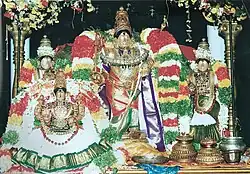
In the Tamil month of Thai, the temple celebrates the Thai Utsavam with a series of events. It begins with the Makara Sankranti Theerthavari on the first day. The second day features Sri Sengamala Thayar’s Kanu Purappadu and Theerthavari, followed by Sri Rajagopalaswamy’s Kanu Parivettai on the Golden Horse Vahanam. The third day marks the Pranaya Kalahotsavam, and the fourth concludes with the Ekasimmasanam Serthi Unjal Sevai, signifying divine unity. In this month, the Adhyayana Utsavam for Sri Sengamala Thayar is also celebrated over ten days. The Thirunakshatram of Moolavar Sri Shenbagalakshmi Thayar is observed on Thai Poosam with special Thirumanjanam and Theerthavari, accompanied by traditional music and Vedic rituals. These observances highlight the goddess’s grace, benevolence, and maternal protection.
Maasi (February–March)
The Tamil month of Maasi is primarily marked by the celebration of the Kannadi Unjal Sevai, also known as the Maasi Dolotsavam, which serves as the main festival of the month. As part of this utsavam, the deities are seated on a beautifully decorated swing adorned with mirrors and lights, creating a reflective and visually striking devotional setting. The event symbolizes divine grace and balance and is celebrated with Vedic chanting, floral offerings, and musical accompaniment. As an integral part of the Dolotsavam, the Maasi Magham Theerthavari is observed at the Haridra Nadhi, where the processional deities are ceremonially bathed in the sacred tank. Devotees also participate in this ritual bath, which is believed to purify and bestow spiritual merit. These festivals, deeply rooted in Vaishnavite tradition, reflect the spiritual and cultural significance of Sri Vidhya Rajagopalaswamy Temple throughout the year.[18]
Religious importance
The verse numbered 3295 [19] in the Nalayira Divya Prabandham is part of Thiruvaimozhi, appearing in the Fourth Centum, Sixth Decade and Tenth Verse, composed by the saint Nammazhvar. In the traditional commentary (Thiruvaimozhi Vyakhyanam – Eedu), this corresponds to section 4-6-10. [20]
unniththu maRRoru dheyvam thozhAL avanai allAl
num ichchai solli num thOL kulaikkap padum annaimIr!
mannap padu maRai vANanai vaN thuvarApathi
mannanai Eththumin Eththudhalum thozhudhAdumE
This particular verse of Thiruvaimozhi was reverentially offered at the Mannargudi Sri Rajamannar Temple by Manavala Mamunigal, a revered Sri Vaishnava acharya. The location associated with this recital is the Dakshina Dwaraka (Southern Dvaraka) of the temple. There is also a belief that in this Thiruvaimozhi pasuram, Nammazhvar may have actually directed his praise towards the presiding deity of Mannargudi; however, the temple is traditionally regarded as an Abhimana Sthalam, which are considered holy temples in Vaishnava tradition. Swami Manavala Mamunigal is also traditionally associated with the composition of the Sri Gopāla Vimśati [21], offered in praise of Sri Vidya Rajagopalaswamy. This devotional work celebrates the Lord’s enchanting beauty, divine leelas, and supreme majesty as the cowherd Krishna of Mannargudi, portraying Him as the ultimate protector and refuge of His devotees. In addition, Mamunigal composed the Sri Kamala Stuti [22], dedicated to Sri Sengamala Thayar (also called Sri Sengamalavalli Thayar), the divine consort of Sri Rajamannar at Mannargudi. This stuti extols the benevolence, compassion, and supreme grace of the goddess, depicting her as the embodiment of Dayā (compassion) and the ultimate source of solace for devotees. In these stotras, Mamunigal glorified Sri Vidya Rajagopalaswamy and Sri Sengamala Thayar, emphasizing the sacred significance of Mannargudi as their divine abode.
Thirumangai Alvar is believed to have built the tall flag post outside the temple with the help of cotton bales. He also is believed to have sung praises about the presiding deity, but the songs were lost with time. The other Alvars who are believed to have visited the temple at various periods were seemingly lost in memory under the beauty of the presiding deity and were at loss of words.[5] Sri Purandara dasaru, a Kannada Hari dasa, known as Pithamaha of Carnatic music had visited this place and glorified the God by composing a Kannada song " Kande Mannaru Krisha na" and "Mannaru Krishnanege Mangala". He is from Vijaya nagara empire. Even Sri Vijaya Dasaru also has composed song on this God.
Notes
- ^ Tourist guide to Tamil Nadu 2007 , p. 64.
- ^ a b c d South Indian Railway Co., Ltd 2004, p. 176
- ^ T. 2002, p. 119
- ^ M., Rajagopalan (1993). 15 Vaishnava Temples of Tamil Nadu. Chennai, India: Govindaswamy Printers. pp. 76–88.
- ^ a b Anantharaman, Ambujam (2006). Temples of South India. East West Books (Madras). pp. 58–59. ISBN 978-81-88661-42-8.
- ^ "Rajagopalaswami Temple : Rajagopalaswami Temple Details | Rajagopalaswami- Mannargudi | Tamilnadu Temple | ராஜகோபாலசுவாமி". temple.dinamalar.com. Retrieved 15 July 2025.
- ^ R, Jolly (5 April 2010). "Divya Darisanam: Purana Sthalams - Rajagopalaswamy Temple, Mannargudi, Thanjavur". Divya Darisanam. Retrieved 15 July 2025.
- ^ R, Jolly (5 April 2010). "Divya Darisanam: Purana Sthalams - Rajagopalaswamy Temple, Mannargudi, Thanjavur". Divya Darisanam. Retrieved 15 July 2025.
- ^ Ilamurugan (28 April 2017). "Tamilnadu Tourism: Rajagopalaswamy Temple, Mannargudi – The Temple". Tamilnadu Tourism. Retrieved 15 July 2025.
- ^ a b S. 2009, pp. 3–7
- ^ Imperial gazetteer of India: Provincial series, Volume 18, p. 159
- ^ a b V. 1995, p. 159
- ^ Imperial gazetteer of India: Provincial series, Vol. 18, p. 137
- ^ Branfoot, Crispin (2008). "Imperial Frontiers: Building Sacred Space in Sixteenth-Century South India". The Art Bulletin. 90 (2): 185. doi:10.1080/00043079.2008.10786389. JSTOR 20619601.(subscription required)
- ^ T.K. 2010, p. 50
- ^ K. V., Soundara Rajan (1967). "The Typology of the Anantaśayī Icon". Artibus Asiae. 29 (1): 80. doi:10.2307/3250291. JSTOR 3250291.
- ^ "மன்னார்குடி ராஜகோபால சுவாமி கோயிலில் வெண்ணெய்த்தாழி உற்சவம்: சுவாமி மீது வெண்ணெய் வீசி பக்தர்கள் வழிபாடு". Hindu Tamil Thisai (in Tamil). 12 April 2024. Retrieved 30 July 2025.
- ^ "Sri Rajagopalaswamy Temple". Dinamalar. Retrieved 4 May 2013.
- ^ "(3295)". Dravidaveda. 29 December 2010. Retrieved 17 August 2025.
- ^ "thiruvAimozhi – 4.6.10 – unniththu – KOYIL". 11 March 2017. Retrieved 17 August 2025.
- ^ "Sri Gopala Vimsadi | Dharma Sandeha". Retrieved 19 August 2025.
- ^ "Mamunigal Koorum Mahalakshmi Vaibhavam (Kamala Stuti) – Srivaishnava Sampradayam". 17 November 2020. Retrieved 19 August 2025.
References
- V., Vriddhagirisan (1995). Nayaks of Tanjore. New Delhi: Asian Educational Services. ISBN 81-206-0996-4.
- T.K., Venkatasubramanian (2010). Music as history in Tamilnadu. Delhi: Premium Books. ISBN 978-93-8060-706-1.
- Tourist Guide to Tamil Nadu. Sura Books. 2010. p. 64. ISBN 978-81-7478-177-2.
- S., Manickavasagam (2009). Power of Passion. AEG Publishing Group. pp. 3–4. ISBN 978-1-60860-561-3.
- T., Padmaja (2002). Temples of Kr̥ṣṇa in South India: history, art, and traditions in Tamilnāḍu. New Delhi: Shakti Malik. ISBN 81-7017-398-1.
- South Indian Railway Co., Ltd (2002). Illustrated guide to the South Indian Railway (Incorporated in England. New Delhi: Asian Educational Services. ISBN 81-206-1889-0.
